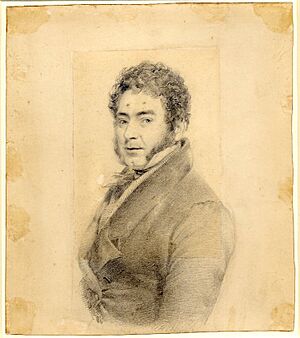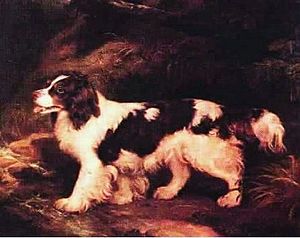Ramsay Richard Reinagle facts for kids

Ramsay Richard Reinagle RA (born March 19, 1775 – died November 17, 1862) was a talented English artist. He painted many different things, like people's portraits, beautiful landscapes, and even animals. He followed in the footsteps of his father, Philip Reinagle, who was also a famous painter.
Contents
A Young Artist's Journey
Ramsay Richard Reinagle learned to paint from his father, Philip Reinagle. He started showing his art at the Royal Academy when he was very young, in 1788. Later, he traveled to Italy and studied art in Rome around 1796. He also visited Holland to learn from the famous Dutch masters.
After returning home, Reinagle worked at a place called Robert Barker's panorama in Leicester Square. Panoramas were huge circular paintings that made viewers feel like they were in the middle of a scene. He then teamed up with Thomas Edward Barker to create their own panorama exhibition in the Strand. They showed giant paintings of places like Rome, the Bay of Naples, Florence, Gibraltar, and Paris. In 1816, they sold their exhibition.
Becoming a Recognized Artist
In 1805, Reinagle became a part of the Royal Watercolour Society, which was a group for artists who painted with watercolors. He became a full member in 1806 and even served as its president from 1808 to 1812. During these years, he sent many watercolor paintings to their shows. Most of these were Italian landscapes and scenes from the English lakes.
At the same time, he also showed his oil paintings, including portraits and landscapes, at the Royal Academy. He became an associate of the Royal Academy in 1814 and a full academician in 1823. Reinagle was very good at copying old paintings. He was often hired by art dealers to fix or "improve" older artworks.
A Difficult Time
In 1848, Ramsay Richard Reinagle faced a big problem. He showed a painting at the Royal Academy exhibition and claimed it was his own work. However, the painting, called Shipping a Breeze and Rainy Weather off Hurst Castle, was actually painted by a young artist named J. W. Yarnold. Reinagle had bought it from a shop and only made a few small changes.
When this was discovered, the Royal Academy investigated. As a result, he was asked to give up his title as a royal academician. He tried to explain himself in some letters published in a newspaper in 1850, but it didn't change the outcome.
He continued to show his paintings at the academy until 1857. In his later years, he became very poor. The Royal Academy helped him by giving him a pension. He passed away in Chelsea on November 17, 1862.
Reinagle's Artworks and Contributions
Many of Reinagle's artworks were turned into engravings for books and publications. For example, three pictures of Richmond, Sion House, and The Opening of Waterloo Bridge were engraved for a book about the River Thames. He also created many illustrations for a book called Peacock's Polite Repository between 1818 and 1830.
His paintings are now part of collections in several British art institutions. You can find his work in places like Sheffield, Rotherham, Doncaster, and the Derby Art Gallery. Some of his art is also held in the Government Art Collection.
Reinagle also wrote about art. He wrote the scientific notes for Turner's Views in Sussex, which was published in 1819. He also wrote about the life of artist Allan Ramsay for a book called Lives of the British Painters.
Family Life
Ramsay Richard Reinagle married Oriana Bullfinch in 1801. They had three sons, and one of them, George Philip Reinagle, also became a painter. They also had a daughter named Oriana Jane.


